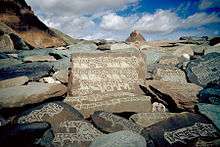Mani stone
| Part of a series on |
| Tibetan Buddhism |
|---|
 |
|
Practices and attainment |
|
History and overview |
|

Mani stones are stone plates, rocks and/or pebbles, inscribed with the six syllabled mantra of Avalokiteshvara[1] (Om mani padme hum, hence the name "Mani stone"), as a form of prayer in Tibetan Buddhism. The term Mani stone may also be used in a loose sense to refer to stones on which any mantra or devotional designs (such as ashtamangala) are inscribed. Mani stones are intentionally placed along the roadsides and rivers[1] or placed together to form mounds[1] or cairns[2] or sometimes long walls, as an offering to spirits of place or genius loci. Creating and carving mani stones as devotional or intentional process art is a traditional sadhana of piety to yidam. Mani stones are a form of devotional cintamani.



Mani walls
Along the paths of regions under the influence of Tibetan Buddhism the traveller is often confronted with Mani walls.[3] These stone structures are a compilation intricately carved stone tablets, most with the inscription "Om Mani Padme Hum"[3] which loosely translates to "Hail to the jewel in the lotus".[4] These walls should be passed or circumvented from the left side, the clockwise direction in which the earth and the universe revolve, according to Buddhist doctrine.
They are sometimes close to a temple or chorten, sometimes completely isolated and range from a few metres to a kilometre long and one to two metres high. They are built of rubble and sand and faced with mani stones engraved in the elegant Tibetan script.[5]
Nepal

The same type of Mani stones can be seen in neighbouring Nepal, where Buddhism is also widely practised. Large examples of Mani stones resembling tablets carved out of the sides of rock formations are in locations throughout the Nepali areas of the Himalayas, such as Namche Bazar. Mani stone walls are most numerous in the high country of the Khumbu. The mantra of Avalokiteshvara is also a common design on prayer wheels and prayer flags in Nepal.
See also
- Om mani padme hum
- Stele of Sulaiman, 1348 stele with Om mani padme hum inscribed in six scripts
- Yongning Temple Stele, 1413 stele with Om mani padme hum inscribed in four scripts
References
- 1 2 3 Mani Stone
- ↑ Mani stone at the British Museum
- 1 2 Tibet Trip
- ↑ Dharma-Haven
- ↑ Rizvi, Janet. 1998. Ladakh, Crossroads of High Asia. Oxford University Press. 1st edition 1963. 2nd revised edition 1996. Oxford India Paperbacks 1998. 3rd impression 2001. pg. 205. ISBN 0-19-564546-4
Longest Mani stone wall in the world Tibetan Stone and Rock Carvings
External links
| Wikimedia Commons has media related to Mani stones. |
